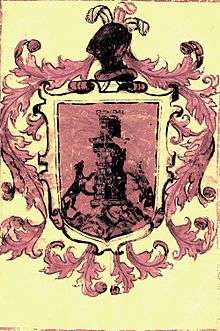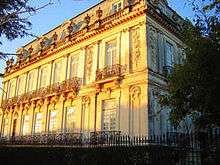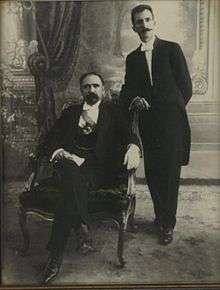De la Cámara
The House of Cámara, alternately de la Cámara, is an aristocratic family originally from the medieval Kingdom of Galicia, part of modern-day Spain and Portugal. The Cámara family was ennobled by King Ferdinand III of Castile in the 13th century, during the Reconquista, and they were one of the few patrician families of the old world which settled in the new world. Although descendants of the House of Cámara are now dispersed throughout Europe and the Americas, the most prominent branch of the family are direct descendants of Juan de la Cámara (1525–1602), a Spanish conquistador who participated in the conquest of the Yucatán Peninsula during the 16th century. His descendants settled in Mérida, Yucatán, and would go on to play a distinguished role in the social, political and economic life of the Yucatán Peninsula and Mexico. Because of their influence and the fact that they intermarried only with other select, upper-class families of European descent, they formed part of a narrow social group known as the Castas divinas (divine castes) of the Yucatán.

Early origins
The name de la Cámara derives from the Medieval Spanish word for chamber, indicating to be part of the king's court.
In 1227 King Ferdinand III of Castile ordered by royal edict that the coat of arms of the knights who assisted him battle be displayed in Baeza. Don Gonzalo de la Cámara[1][2] been one of the knights. In 1393 King Henry III of Castile, confirmed the hereditary nobility and gave Gómez Ruiz, a Gallician knight who was born to a hidalgo family the papers.
Gómez Ruiz de la Cámara was later married to one Queen of Castile Catherine of Lancaster's lady in waiting. The marriage was approved by King Ferdinand III of Castile. Notable descendants include Juan Rodríguez de la Cámara Galician writer and page to King Juan II of Castile.,[3] considered the last poet of the Galician school and Juan de la Cámara who assisted in the founding of the city Mérida, Yucatán.
Originally members of the hidalgo Spanish and Portuguese nobility. The most direct line of descendants settled in the Yucatán Peninsula during the Spanish conquest of Yucatán during the early 16th century, and they have lived in Mexico for 14 generations with the same last name and they can trace there direct linage back to the High Middle Ages to Gómez Ruiz de la Cámara during the 1200s.

Migration
Many members of the family migrated to the Americas to take part in the Spanish colonization of the Americas, some include:
Spanish conquest of Yucatán
- Juan de la Cámara who arrived to New Spain (current day Mexico) in 1539.
- Baltasar de la Cámara who arrived to New Spain in 1565.
- Juana de la Cámara who arrived to New Spain during the 16th century with his three sisters.
Other Spanish colonies
- Diego de la Cámara who arrived to Ecuador in 1584.
- Pedro de la Cámara who arrived to the Philippines in 1594.
Settlers in the United States in the 19th century
- Francisco V Cámara Peresteitto who arrived to New York City in 1822.
- Juan Cámara, who arrived to Puerto Rico in 1860.[4]
- Manuel Cámara, who arrived in Puerto Rico in 1898.
Notable family members

- Gómez Ruiz de la Cámara. Born in the 14th century in Galicia. Given the title "Knight of the King's Chamber" in 1393, where the surname de la Cámara originated.
- Alfonso Ruiz de la Cámara. Spanish nobleman, who was knighted "Caballero de Espuelas Doradas" August 15, 1487 by King Ferdinand II of Aragón, who was King of Sicily from 1468, King of Aragon from 1479 and King of Castile in his right of his wife, Isabella I, from 1475.
- Gómez Fernández de la Cámara He was given by Royal Decree the title of "Secretary and Royal Scribe" and "Royal Notary of the Court" by the King John II of Castile March 9, 1453.
- Gonzalo de la Cámara Was a Spanish knight,his Coat of Arms was displayed in the city of Baeza in 1227,by order from King Ferdinand III of Castile,because he was at the King's side during the battle for the city.[5]
- Juan de la Cámara (1525–1602). Spanish Conquistador, born in Alcalá de Henares. Arrived in New Spain's First Viceroy (current day Mexico), from Spain in 1539, and took part in the Conquest of Yucatán in 1541, was one of the founders of Mérida, Yucatán. His descendants have lived in Mexico for more than 14 generations and brought with them their old titles from Europe. Mexican nobility.
- Manuel de la Cámara y Libermoore (May 7, 1835–?). Rear Admiral of the Spanish Navy during the Spanish–American War, born in Málaga, Spain.
- Juan Rodríguez de la Cámara (1390–1450). Galician writer and poet, considered the last poet of the Galician school. Born in Padrón, Galicia (Spain).[6]
- Isabel Montero de la Cámara Costa Rican diplomat, born in San José, Costa Rica, in 1942
- Nicolás Camára Vales (1875–1956). Mexican pediatrician and politician born in Mérida, Yucatán, who served a Governor of Yucatán[7]
- Alfredo Cámara Vales, a Mexican politician and businessman who served as Governor of Quintana Roo
- Maria Cámara Vales (1877–1969) was the Second Lady of Mexico and she was awarded the Belisario Dominguez Congressional Medal of Honour in 1969, the highest award granted to a Mexican civilian. She was the wife of José María Pino Suárez, who served as Vice President of Mexico, Minister of Education and the Fine Arts, President of the Senate, Minister of Justice and Governor of Yucatán. She is the sister of Nicolas Cámara Vales and Alfredo Cámara Vales.
- Aida Pino Cámara (1904–1993), an aristocrat and socialite, she was the daughter of José María Pino Suárez, vice president of Mexico, and the mother of Ismael Moreno Pino, a senior diplomat who served as Ambassador in Germany and the Netherlands.
- Felix Achille de la Cámara (1897–1945). Writer and artist of Spanish origin, born in Kutná Hora in the Central Bohemian Region of Bohemia, which is now part of the Czech Republic.
- Juan Francisco de la Cámara y O'Reilly, 6th Count of Buenavista.
- Juan de la Cámara y Goicoechea 7th Count of Buenavista.
- María de las Mercedes de la Cámara y Goicoechea 8th Countess of Buenavista.
- Gonzalo Cámara Zavala (1864–1967) Mexican philanthropist, lawyer and writer. Born in Mérida, Yucatán.
References
- Archivo General de Indias – Mexico 971-Pag. 316 vat.
- Enrique Cámara Peon |Probanza Genealogica Nobiliaria-Mexico 1985.
- ↑ Archivo General de Indies- Mexico 971-Pag. 381-Anexo G-1.
- ↑ Book of Lorenzo Suárez de Mendoza, 4th conde de la Coruña and 5th Viceroy of the New Spain -October 20, 1581-Mexico
- ↑ "Biagrafia de Juan Rodríguez de la Cámara.". Biografías y Vidas. Retrieved 2013.
- ↑ "Camara Surname History". House of Names. Retrieved 2013.
- ↑ Book of Lorenzo Suárez de Mendoza, 4th conde de la Coruña and 5th Viceroy of the New Spain -October 20, 1581-Mexico
- ↑ Juan Rodriguez del Padron
- ↑ "Leyes y Decretos de la Revolución en Yucatán". Por Esto!. Retrieved 6 July 2012.